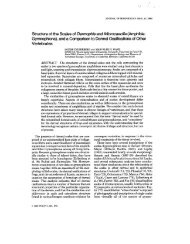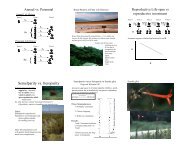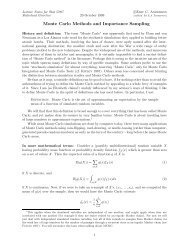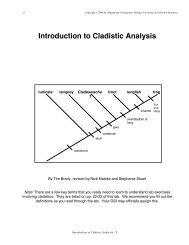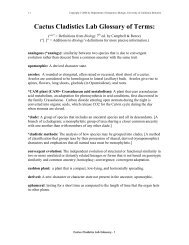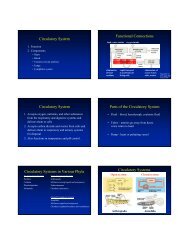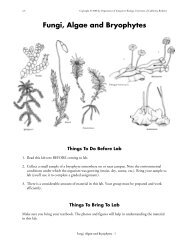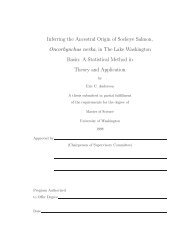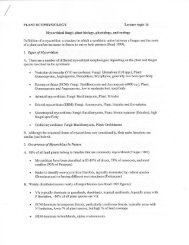Using ecological niche modeling for quantitative biogeographic ...
Using ecological niche modeling for quantitative biogeographic ...
Using ecological niche modeling for quantitative biogeographic ...
Create successful ePaper yourself
Turn your PDF publications into a flip-book with our unique Google optimized e-Paper software.
604 KAITLIN C. MAGUIRE AND ALYCIA L. STIGALL<br />
coupled with low speciation rates that eventually<br />
decline to zero. Although climatic<br />
deterioration, as hypothesized by MacFadden<br />
(1992), may explain the increased rate of<br />
extinction, the increase in continuous habitat<br />
following the spread of grasslands, and the<br />
concomitant reduction in opportunities <strong>for</strong><br />
speciation, likely contributed significantly to<br />
the observed reduction in speciation. Maguire<br />
and Stigall (2008) previously noted that<br />
speciation by vicariance occurred much less<br />
frequently in equids than in modern continental<br />
taxa (e.g., Wiley and Mayden 1985).<br />
Consequently, this additional reduction in the<br />
amount of vicariant speciation in the Equinae<br />
due to geographic continuity during the late<br />
Miocene and early Pliocene may have been<br />
influential in the decline of the clade.<br />
Habitat Tracking<br />
As temperatures decreased during the<br />
Miocene and the climate became more arid,<br />
several species adapted to woodlands and<br />
savannas rather than open grasslands retreated<br />
to warmer and wetter regions of North<br />
America, specifically the southern Great<br />
Plains and Gulf Coast regions (e.g., Nannippus<br />
aztecus, Fig. 4C) (Webb et al. 1995). <strong>Using</strong> data<br />
from carbonate nodules, Retallack (2007)<br />
identified a climatic gradient from warm<br />
and humid in the coastal regions to cool and<br />
arid in the northern Great Plains region.<br />
Species of Equinae in the Hemphillian–Blancan<br />
time slice of this study occupied larger<br />
ranges south of 38.5uN, than species of the<br />
Barstovian–Clarendonian time slice below<br />
39uN (two-sample t-test, p 5 0.009) (Table 7).<br />
This southward <strong>biogeographic</strong> shift indicates<br />
that species tracked their preferred habitat<br />
toward the south as climate changed more<br />
drastically in the northern regions of North<br />
America. This demonstrates the potential use<br />
of ENM and the fossil record as tools to track<br />
patterns of climate change and <strong>biogeographic</strong>al<br />
responses. Further examination of morphological<br />
differences and dietary adaptations<br />
between species that migrated south<br />
and those that retained a northern range<br />
would further test this hypothesis. The<br />
southward range shift may partially result<br />
from the distribution of species occurrence<br />
points (Fig. 2). The early time slice has a<br />
higher concentration of species occurrence<br />
points in the northern part of the Great Plains,<br />
whereas the late time slice has a more even<br />
distribution of points across the Great Plains.<br />
Because the GARP algorithm is designed to<br />
analyze data from poorly structured domains<br />
including unevenly distributed species occurrence<br />
data (Stockwell and Peterson 2002), the<br />
uneven data distribution is unlikely to skew<br />
the resulting range predictions significantly.<br />
Furthermore, the distribution of occurrence<br />
points in the early time slice may in fact be an<br />
accurate representation of the distribution of<br />
Equinae species, and thus the more northern<br />
range of equids relative to the late time slice.<br />
By the Hemphillian, the southwestern<br />
region of North America was semiarid and<br />
dominated by shrubland vegetation (Axelrod<br />
1985). Many ungulates retreated from this<br />
region into the Great Plains (Webb et al. 1995).<br />
This included five species that were modeled<br />
in the Hemphillian–Blancan time slice: Dinohippus<br />
leidyanus, Dinohippus interpolatus, Equus<br />
simplicidens, Astrohippus ansae, and Astrohippus<br />
stockii (Maguire and Stigall 2008). Maguire<br />
and Stigall (2008) determined that speciation<br />
of these five taxa was a result of geodispersal<br />
across the Rocky Mountains from the Southwest<br />
to the Great Plains. Predicted geographic<br />
distributions of these five species are similar<br />
and occur predominantly on the western edge<br />
of the Great Plains region (Fig. 4D,E). During<br />
the Neogene, the uplift of the Rocky Mountains<br />
was interrupted by intervals of tectonic<br />
quiescence (Condon 2005). Consequently,<br />
during these intervals of quiescence and<br />
erosion, equid species could migrate across<br />
the Cordilleran region, whereas orogenic<br />
pulses resulted in barriers to species movement.<br />
The distribution patterns predicted<br />
from <strong>niche</strong> <strong>modeling</strong> supports the conclusion<br />
of Maguire and Stigall (2008) that speciation<br />
of these five species was a result of a cyclical<br />
geodispersal process as habitat tracking occurred<br />
across the Rocky Mountains during<br />
these tectonic cycles.<br />
As mentioned previously, one species,<br />
Cormohipparion occidentale, was extant during<br />
both time slices. The species’ predicted<br />
distributions <strong>for</strong> the Barstovian–Clarendonian



